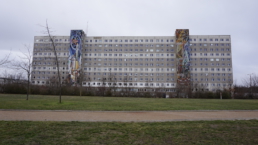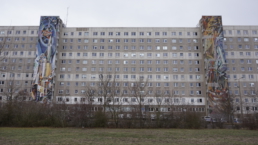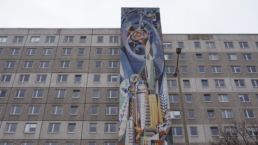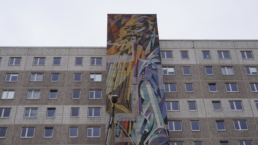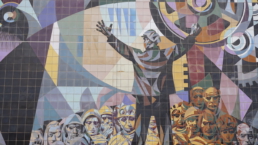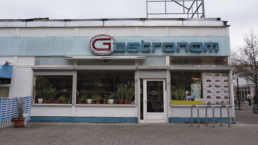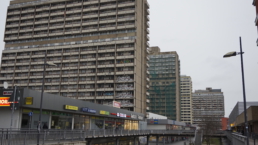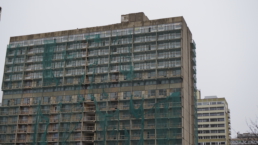Designed without street names, navigating Halle Neustadt was no easy feat for the city’s residents.
When planners began developing the socialist model town in the early 60s, Karl-Marx-Straßes were given amiss, and buildings were allocated a three-digit number instead.
To shake things up even more, the numbers were not organised chronologically, but calculated in relation to how many roads away they were from the city’s central axis.
Luckily, many of Halle Neustadt’s residents were used to working on equations a little more complex. The city was built from scratch for the purpose of housing engineers, scientists, and other mathematically-minded workers employed at two nearby chemical production sites – Buna Schkopau, and Leuna.
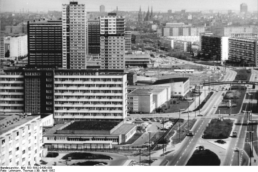
Designing Utopia
With the first wave of tenants moving there in 1965, Halle Neustadt was one of the German Democratic Republic’s earlier attempts at veering beyond building a mere settlement – instead planning an entire city.
The urban planning was ideological to its core, aiming to educate and foster the development of an ideal socialist society. Fundamentally, the objective was to create equal conditions for everyone. This was implemented in numerous ways, from making sure that everyone had the luxury of heating and hot water, to creating flats that had at least one south-facing room for maximum sunlight.
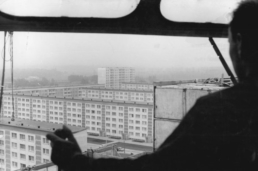
To brighten up the place further, artworks were scattered throughout public spaces, transforming the city into an open-air gallery. There were artfully designed play areas, statues, fountains, and mosaics, all adding character to the otherwise largely monotonous landscape of Plattenbau facades.
Two of the area’s most impressive works of art can be found tucked behind the main train station. Through the trees, a lionesque depiction of Karl Marx peeks out from the top of a drab, grey building, guarding two enormous mosaic slabs.
The murals were created in 1974 by Josep Renau, a Valencian artist who settled in East Germany after escaping the Franconian dictatorship.
The first piece, named ‘The man-controlled forces of nature and technology’, sees a crowd of protesters and miners power an explosion of industrial force. It culminates in the development of science and technology, represented through microscopes and a cosmos of stars.
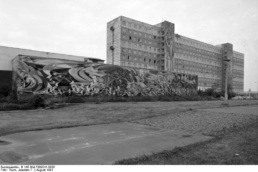
The other work, ‘The unity of the working class and the founding of the GDR’, actually had gone through a redesign prior to its creation, after the Advisory Council for Visual Arts recommended that it should be more political thematically, and adhere to the iconographic tendencies of socialist realism, thus leading to the integration of Marx.
There was originally a third mural, called “The march of youth”, however in 1998, this was demolished. In 2005, the remaining murals underwent restoration. You can read more about Halle Neustadt’s public artworks here.
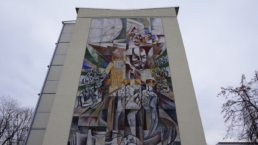
Open Spaces
Priority was given to the creation of large green spaces, which cover some 42% of the city. The area was designed to be pedestrian-friendly, and few roads sliced through the estate, with moat-like thoroughfares circling around the buildings instead.
The pedestrianisation of the area was both a blessing and a curse, particularly given the lack of transport connections in the city. Plans for a Neustadt centre, which would have had tram stops, never materialised during the GDR era, and the lack of roads meant there were no bus routes.
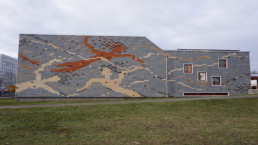
All connections to the old city and chemical factories were from the main train station. While one could be whisked off from the station to work in just 11 minutes, early starts at the chemical factory were particularly taxing to those who lived in flats that were buried in the depths of the estate. Other infrastructural frustrations included the lack of facilities, with restaurants and bars few in number.
Nevertheless, the city grew over the years and developed housing projects to match demand. It was home to the DDR’s largest residential building – ‘Block 10’- which housed some 3,000 residents at its peak. Stretching over 380 metres, it contained 320 multi-room and 536 one-room apartments, and was built in just six months. More complexes were built in the years to follow, and by the late 80s, Halle Neustadt was home to some 90,000 people.
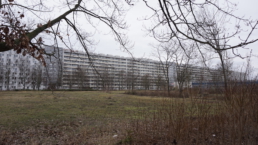
Ha Neu
After the fall of the wall, the city witnessed the introduction of several infrastructural changes. Following years of operating in the numeric system, Halle Neustadt dropped the digits and started using street names. Transport connections to the old city were constructed, and the area was given a town hall.
But in a case of too little too late, it wasn’t enough to keep the population there after reunification. As the socialist system was dismantled, public enterprises were privatised, leading to mass unemployment, particularly in industrialised areas like Halle Neustadt. By 1999, more than a third of the city’s population had left.
Today, the buildings facing the train station stand skeltal. Locals affectionately call the area ‘Ha Neu’ (Ha-noi) – a reference to Vietnam’s bombed out capital in the 80s. However, the estate now resembles more of a ghost town than a war zone. While the ambitious plans for the city may not have not fully realised, traces of what could have been, remain entrenched in the area’s core. The streets are quiet, the green spaces are clean and tranquil, and a well-preserved Marx continues to keep a watchful eye over the city.
Unity of the working class and founding of the GDR and The man-controlled forces of nature and technology
